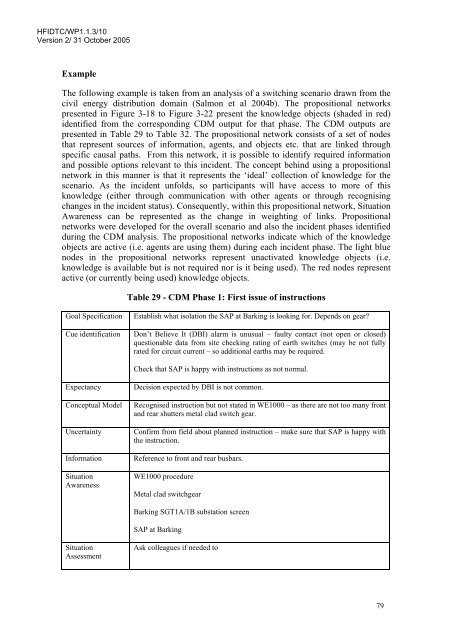A Review of the Event Analysis of Systemic Teamwork Methodology
A Review of the Event Analysis of Systemic Teamwork Methodology
A Review of the Event Analysis of Systemic Teamwork Methodology
- No tags were found...
Create successful ePaper yourself
Turn your PDF publications into a flip-book with our unique Google optimized e-Paper software.
HFIDTC/WP1.1.3/10<br />
Version 2/ 31 October 2005<br />
Example<br />
The following example is taken from an analysis <strong>of</strong> a switching scenario drawn from <strong>the</strong><br />
civil energy distribution domain (Salmon et al 2004b). The propositional networks<br />
presented in Figure 3-18 to Figure 3-22 present <strong>the</strong> knowledge objects (shaded in red)<br />
identified from <strong>the</strong> corresponding CDM output for that phase. The CDM outputs are<br />
presented in Table 29 to Table 32. The propositional network consists <strong>of</strong> a set <strong>of</strong> nodes<br />
that represent sources <strong>of</strong> information, agents, and objects etc. that are linked through<br />
specific causal paths. From this network, it is possible to identify required information<br />
and possible options relevant to this incident. The concept behind using a propositional<br />
network in this manner is that it represents <strong>the</strong> ‘ideal’ collection <strong>of</strong> knowledge for <strong>the</strong><br />
scenario. As <strong>the</strong> incident unfolds, so participants will have access to more <strong>of</strong> this<br />
knowledge (ei<strong>the</strong>r through communication with o<strong>the</strong>r agents or through recognising<br />
changes in <strong>the</strong> incident status). Consequently, within this propositional network, Situation<br />
Awareness can be represented as <strong>the</strong> change in weighting <strong>of</strong> links. Propositional<br />
networks were developed for <strong>the</strong> overall scenario and also <strong>the</strong> incident phases identified<br />
during <strong>the</strong> CDM analysis. The propositional networks indicate which <strong>of</strong> <strong>the</strong> knowledge<br />
objects are active (i.e. agents are using <strong>the</strong>m) during each incident phase. The light blue<br />
nodes in <strong>the</strong> propositional networks represent unactivated knowledge objects (i.e.<br />
knowledge is available but is not required nor is it being used). The red nodes represent<br />
active (or currently being used) knowledge objects.<br />
Table 29 - CDM Phase 1: First issue <strong>of</strong> instructions<br />
Goal Specification<br />
Cue identification<br />
Establish what isolation <strong>the</strong> SAP at Barking is looking for. Depends on gear<br />
Don’t Believe It (DBI) alarm is unusual – faulty contact (not open or closed)<br />
questionable data from site checking rating <strong>of</strong> earth switches (may be not fully<br />
rated for circuit current – so additional earths may be required.<br />
Check that SAP is happy with instructions as not normal.<br />
Expectancy<br />
Conceptual Model<br />
Uncertainty<br />
Information<br />
Situation<br />
Awareness<br />
Decision expected by DBI is not common.<br />
Recognised instruction but not stated in WE1000 – as <strong>the</strong>re are not too many front<br />
and rear shutters metal clad switch gear.<br />
Confirm from field about planned instruction – make sure that SAP is happy with<br />
<strong>the</strong> instruction.<br />
Reference to front and rear busbars.<br />
WE1000 procedure<br />
Metal clad switchgear<br />
Barking SGT1A/1B substation screen<br />
SAP at Barking<br />
Situation<br />
Assessment<br />
Ask colleagues if needed to<br />
79
















